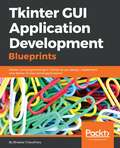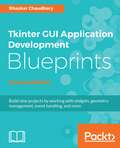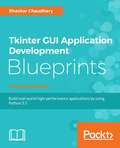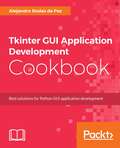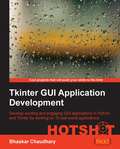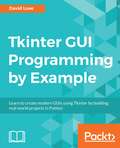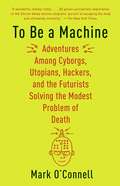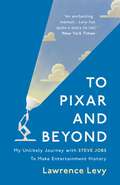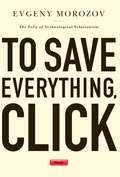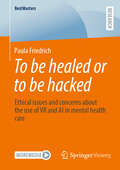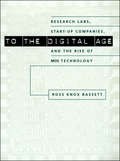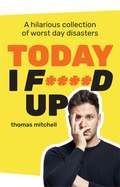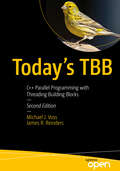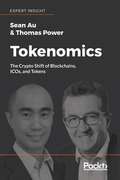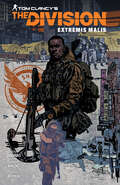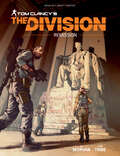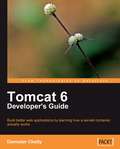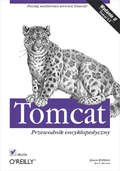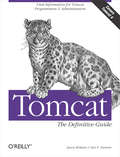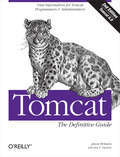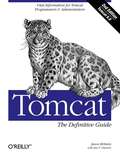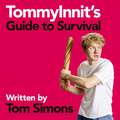- Table View
- List View
Tkinter GUI Application Development Blueprints
by Bhaskar ChaudharyGeometry Management, Event Handling, and more Key Features A Practical, guide to learn the application of Python and GUI programming with tkinter Create multiple cross-platform real-world projects by integrating host of third party libraries and tools Learn to build beautiful and highly interactive user interfaces, targeting multiple devices. Book Description Tkinter is the built-in GUI package that comes with standard Python distributions. It is a cross-platform package, which means you build once and deploy everywhere. It is simple to use and intuitive in nature, making it suitable for programmers and non-programmers alike. This book will help you master the art of GUI programming. It delivers the bigger picture of GUI programming by building real-world, productive, and fun applications such as a text editor, drum machine, game of chess, audio player, drawing application, piano tutor, chat application, screen saver, port scanner, and much more. In every project, you will build on the skills acquired in the previous project and gain more expertise. You will learn to write multithreaded programs, network programs, database-driven programs, asyncio based programming and more. You will also get to know the modern best practices involved in writing GUI apps. With its rich source of sample code, you can build upon the knowledge gained with this book and use it in your own projects in the discipline of your choice. What you will learn -A Practical, guide to help you learn the application of Python and GUI programming with Tkinter - Create multiple, cross-platform, real-world projects by integrating a host of third-party libraries and tools - Learn to build beautiful and highly interactive user interfaces, targeting multiple devices. Who this book is for This book is for a beginner to intermediate-level Pythonists who want to build modern, cross-platform GUI applications with the amazingly powerful Tkinter. Prior knowledge of Tkinter is required.
Tkinter GUI Application Development Blueprints, Second Edition: Build Nine Projects By Working With Widgets, Geometry Management, Event Handling, And More, 2nd Edition
by Bhaskar ChaudharyTkinter is the built-in GUI package that comes with standard Python distributions. It is a cross-platform package, which means you build once and deploy everywhere. It is simple to use and intuitive in nature, making it suitable for learners. This book will enable you to use Tkinter effectively through working on nine versatile projects.
Tkinter GUI Application Development Blueprints, Second Edition: Build nine projects by working with widgets, geometry management, event handling, and more, 2nd Edition
by Bhaskar Chaudhary Erik S. RapertGeometry Management, Event Handling, and moreKey FeaturesA Practical, guide to learn the application of Python and GUI programming with tkinterCreate multiple cross-platform real-world projects by integrating host of third party libraries and toolsLearn to build beautiful and highly interactive user interfaces, targeting multiple devices.Book DescriptionTkinter is the built-in GUI package that comes with standard Python distributions. It is a cross-platform package, which means you build once and deploy everywhere. It is simple to use and intuitive in nature, making it suitable for programmers and non-programmers alike.This book will help you master the art of GUI programming. It delivers the bigger picture of GUI programming by building real-world, productive, and fun applications such as a text editor, drum machine, game of chess, audio player, drawing application, piano tutor, chat application, screen saver, port scanner, and much more. In every project, you will build on the skills acquired in the previous project and gain more expertise. You will learn to write multithreaded programs, network programs, database-driven programs, asyncio based programming and more. You will also get to know the modern best practices involved in writing GUI apps. With its rich source of sample code, you can build upon the knowledge gained with this book and use it in your own projects in the discipline of your choice.What you will learn-A Practical, guide to help you learn the application of Python and GUI programming with Tkinter- Create multiple, cross-platform, real-world projects by integrating a host of third-party libraries and tools- Learn to build beautiful and highly interactive user interfaces, targeting multiple devices.Who this book is forThis book is for a beginner to intermediate-level Pythonists who want to build modern, cross-platform GUI applications with the amazingly powerful Tkinter. Prior knowledge of Tkinter is required.
Tkinter GUI Application Development Cookbook: A practical solution to your GUI development problems with Python and Tkinter
by Alejandro Rodas de PazDiscover solutions to all your Tkinter and Python GUI development problemsKey Features Integrate efficient Python GUI programming techniques with Tkinter Efficiently implement advanced MVC architectures in your Python GUI apps Solve all your problems related to Tkinter and Python GUI developmentBook DescriptionAs one of the more versatile programming languages, Python is well-known for its batteries-included philosophy, which includes a rich set of modules in its standard library; Tkinter is the library included for building desktop applications. Due to this, Tkinter is a common choice for rapid GUI development, and more complex applications can benefit from the full capabilities of this library. This book covers all of your Tkinter and Python GUI development problems and solutions.Tkinter GUI Application Development Cookbook starts with an overview of Tkinter classes and at the same time provides recipes for basic topics, such as layout patterns and event handling. Next, we cover how to develop common GUI patterns, such as entering and saving data, navigating through menus and dialogs, and performing long-running actions in the background.You can then make your apps leverage network resources effectively and perform graphical operations on a canvas and related tasks such as detecting collisions between items. Finally, this book covers using themed widgets, an extension of Tk widgets that have a more native look and feel. Finally, this book covers using the canvas and themed widgets.By the end of the book, you will have an in-depth knowledge of Tkinter classes, and will know how to use them to build efficient and rich GUI applications.What you will learnAdd widgets and handle user eventsLay out widgets within windows using frames and the different geometry managersConfigure widgets so that they have a customized appearance and behaviorImprove the navigation of your apps with menus and dialogsApply object-oriented programming techniques in Tkinter applicationsUse threads to achieve responsiveness and update the GUI Explore the capabilities of the canvas widget and the types of items that can be added to itExtend Tkinter applications with the TTK (themed Tkinter) moduleWho this book is forThis book is for Python developers who are familiar with the basics of the language syntax, data structures, and OOP. You do not need previous experience with Tkinter or other GUI development libraries.
Tkinter GUI ApplicationDevelopment HOTSHOT
by Bhaskar ChaudharyPractical, real-world example projects. Start with the topics that grab your attention or work through each project in sequence.If you have just started with GUI programming, this book is ideal for you. This book is also great if you are an experienced software developer, scientist, researcher, engineer, student, or hobbyist.
Tkinter GUI Programming by Example: Learn to create modern GUIs using Tkinter by building real-world projects in Python
by David LoveLeverage the power of Python and its de facto GUI framework to build highly interactive interfacesKey Features The fundamentals of Python and GUI programming with Tkinter. Create multiple cross-platform projects by integrating a host of third-party libraries and tools. Build beautiful and highly-interactive user interfaces that target multiple devices.Book DescriptionTkinter is a modular, cross-platform application development toolkit for Python. When developing GUI-rich applications, the most important choices are which programming language(s) and which GUI framework to use. Python and Tkinter prove to be a great combination. This book will get you familiar with Tkinter by having you create fun and interactive projects. These projects have varying degrees of complexity. We'll start with a simple project, where you'll learn the fundamentals of GUI programming and the basics of working with a Tkinter application. After getting the basics right, we'll move on to creating a project of slightly increased complexity, such as a highly customizable Python editor. In the next project, we'll crank up the complexity level to create an instant messaging app. Toward the end, we'll discuss various ways of packaging our applications so that they can be shared and installed on other machines without the user having to learn how to install and run Python programs.What you will learn Create a scrollable frame via theCanvas widget Use the pack geometry manager andFrame widget to control layout Learn to choose a data structurefor a game Group Tkinter widgets, such asbuttons, canvases, and labels Create a highly customizablePython editor Design and lay out a chat windowWho this book is forThis book is for beginners to GUI programming who haven’t used Tkinter yet and are eager to start building great-looking and user-friendly GUIs. Prior knowledge of Python programming is expected.
Tmi
by Sarah QuigleyFriends call Becca the Overshare Queen, but her tendency for TMI never seemed like a problem to her until she blabs about her sweet band-geek boyfriend's sloppy kisses-and gets dumped! Realizing it may be better to resist the temptation to overshare face-to-face, Becca decides to blog anonymously about everything instead. On her blog, Too Much Information, Becca unleashes her alter ego, Bella. Bella tells it like it is . . . though perhaps with a bit more drama. After all, no one's going to read it, right?
To Be a Machine: Adventures Among Cyborgs, Utopians, Hackers, and the Futurists Solving the Modest Problem of Death
by Mark O'ConnellAn eye-opening journey into a world of visionaries, billionaires, and eccentrics harnessing technology for nothing less than the salvation of mankindTranshumanism is a movement pushing the limits of our bodies—our capabilities, intelligence, and lifespans—in the hopes that, through technology, we can become something better than ourselves. It has found support among Silicon Valley billionaires and some of the world’s biggest businesses. In To Be a Machine, journalist Mark O'Connell explores the staggering possibilities and moral quandaries that present themselves when you of think of your body as a device. He visits the world's foremost cryonics facility to witness how some have chosen to forestall death. He discovers an underground collective of biohackers, implanting electronics under their skin to enhance their senses. He meets a team of scientists urgently investigating how to protect mankind from artificial superintelligence.Where is our obsession with technology leading us? What does the rise of AI mean not just for our offices and homes, but for our humanity? Could the technologies we create to help us eventually bring us to harm? Addressing these questions, O'Connell presents a profound, provocative, often laugh-out-loud-funny look at an influential movement. In investigating what it means to be a machine, he offers a surprising meditation on what it means to be human.
To Pixar and Beyond: My Unlikely Journey with Steve Jobs to Make Entertainment History
by Lawrence LevyA Sunday Times Best Book of the Year 2017 One day in November 1994, Lawrence Levy received a phone call out of the blue from Steve Jobs, whom he&’d never met, offering him a job running Pixar, a little-known company that had already lost Jobs $50 million. With Pixar&’s prospects looking bleak, it was with some trepidation that Levy accepted the position. After a few weeks he discovered that the situation was even worse than he&’d imagined. Pixar&’s advertising division just about broke even, its graphics software had few customers, its short films didn&’t make any money and, on top of all that, Jobs was pushing to take the company public. Everything was riding on the studio&’s first feature film, codenamed Toy Story, and even then it would have to be one of the most successful animated features of all time… Full of wisdom on bringing business and creativity together, and recounting the touching story of Levy&’s enduring friendship with Jobs, To Pixar and Beyond is a fascinating insider&’s account of one of Hollywood&’s greatest success stories.
To Save Everything, Click Here: The Folly of Technological Solutionism
by Evgeny MorozovThe award-winning author of "The Net Delusion" shows how the radical transparency we've become accustomed to online may threaten the spirit of real-life democracy
To be healed or to be hacked: Ethical issues and concerns about the use of VR and AI in mental health care (BestMasters)
by Paula FriedrichThe high prevalence of mental health disorders worldwide has created a big demand on mental health care professionals. To relieve personnel and provide increased access to care, the use of AI and VR has been researched for many decades. As the human-centered implementation of AI remains scarce, we first assessed mental health patients&’ concerns about the use of AI for therapy in an online questionnaire. The pre-study revealed the importance of data autonomy and transparency, which was explored in a subsequent in-person VR study regarding the effect on self-disclosure and trust towards the embodied AI. Results suggest a higher level of self-disclosure with higher data autonomy. Transparency did not influence level of self-disclosure and both autonomy and transparency showed no effect on trust towards the AI. Additionally, an effect of gender on trust was found, showing higher levels of trust for women compared to men. This work contributes to the ethical discussion around AI in mental health care with a human-centered AI perspective and insights into patients&’ concerns on this development.
To the Digital Age: Research Labs, Start-up Companies, and the Rise of MOS Technology (Johns Hopkins Studies in the History of Technology)
by Ross Knox BassettThe metal-oxide-semiconductor (MOS) transistor is the fundamental element of digital electronics. The tens of millions of transistors in a typical home—in personal computers, automobiles, appliances, and toys—are almost all derive from MOS transistors. To the Digital Age examines for the first time the history of this remarkable device, which overthrew the previously dominant bipolar transistor and made digital electronics ubiquitous. Combining technological with corporate history, To the Digital Age examines the breakthroughs of individual innovators as well as the research and development power (and problems) of large companies such as IBM, Intel, and Fairchild.Bassett discusses how the MOS transistor was invented but spurned at Bell Labs, and then how, in the early 1960s, spurred on by the possibilities of integrated circuits, RCA, Fairchild, and IBM all launched substantial MOS R & D programs. The development of the MOS transistor involved an industry-wide effort, and Bassett emphasizes how communication among researchers from different firms played a critical role in advancing the new technology. Bassett sheds substantial new light on the development of the integrated circuit, Moore's Law, the success of Silicon Valley start-ups as compared to vertically integrated East Coast firms, the development of the microprocessor, and IBM's multi-billion-dollar losses in the early 1990s. To the Digital Age offers a captivating account of the intricate R & D process behind a technological device that transformed modern society.
Today I F****d Up
by Thomas MitchellA toe curling, laugh out loud collection of worst day disasters. I&’d always rolled my eyes when people describe things as 'happening in slow motion'. Surely everything happens in regular time and it's only when you replay it in your head that it seems to slow down?But as the car lurched forward and I found myself sailing through the back of the garage, I finally understood what they meant. When a trip to meet his new girlfriend&’s grandparents ends in disaster (think a crashed ute, an angry wasp and a cranky farmer with a shotgun), Thomas Mitchell knows one thing for sure: bad days make for great stories. While we might not like to admit it, we can't help but find a sneaky pleasure in other people's misfortune. It's the reason fail compilations rack up millions of views on YouTube or television shows like Funniest Home Videos exist at all. Deep down we're addicted to the downfall of our fellow humans, and if there was ever a point in history when we needed a laugh, it's now. Today I F***D Up is a collection of tall tales but true that are equal parts hilarious and horrifying; a timely reminder that no matter how terrible things get, they could always be worse. So much worse.
Today's TBB: C++ Parallel Programming with Threading Building Blocks
by Michael J. Voss James R. ReindersThis open-access book serves as a comprehensive guide for C++ programmers looking to master Threading Building Blocks (TBB). Authored by two experts in TBB and parallel programming, the book distills decades of collective experience in developing and teaching parallel programming concepts, presenting insights in a clear and accessible manner. Today&’s TBB starts with foundational principles, explaining key concepts and terminology used in parallel programming. It then introduces the major components of TBB including parallel algorithms, flow graphs, and task groups that help you fully leverage the power of multicore systems. The book emphasizes TBB's higher-level parallelism capabilities, which facilitate the creation of portable, scalable applications for modern CPUs. Key topics, including memory management in parallel contexts and effective synchronization for data structures, are well explored, ensuring a comprehensive understanding of these critical concepts. Later chapters delve into advanced topics including cancellation, exception handling, composability, performance tuning, and transitioning legacy code from older versions of TBB to Today&’s TBB. For nearly two decades, TBB has been invaluable to programmers, and this book leverages the latest advancements in C++ alongside TBB to enhance your parallel programming capabilities. TBB excels in unlocking the performance of code that is not well-suited for accelerators, making it an essential tool in the realm of parallel computing. If you work with technologies like CUDA, SYCL, or OpenCL for accelerated computing, mastering TBB will also enable you to orchestrate parallelism effectively on the host CPU, optimizing performance in the face of Amdahl&’s Law. What You'll Learn Create Scalable Code: Use TBB for portable, simple, and efficient programming. Parallelization Strategies: Implement best practices for intensive tasks. High-Performance Applications: Develop scalable parallel programs. Modern C++ Compatibility: Apply TBB with C++17 and later. Code Migration: Update legacy TBB code to leverage C++17 and Today&’s TBB. Think Parallel: Orchestrate parallelism in the entire computer system to your advantage. Who This Book Is For C++ programmers eager to harness the power of parallelism on multicore systems. Today&’s TBB is accessible to those with limited experience, with C++ or parallelism, providing clear guidance on best practices and techniques. Experienced programmers will find valuable insights for refining their skills, addressing advanced topics such as cancellation, exception handling, composability, and performance tuning. No prior experience in parallel programming or multicore processors is necessary; however, those with some background will discover even more depth and value throughout the book.
Tokenomics: The Crypto Shift of Blockchains, ICOs, and Tokens
by Thomas Power Sean Au<p>Tokenomics is the economy of this new world. This is a no-holds-barred, in-depth exploration of the way in which we can participate in the blockchain economy. The reader will learn the basics of bitcoin, blockchains, and tokenomics; what the very first ICO was; and how over a period of 5 years, various projects managed to raise the enormous sums of money they did. The book then provides insights from ICO experts and looks at what the future holds. By comparing the past, current, and future of this technology, the book will inform anyone, whatever motivates their interest. <p>The crypto shift of blockchains, ICOs, and tokens is much more than just buying bitcoins, creating tokens, or raising millions in a minute in an ICO. It is a new paradigm shift from centralized to decentralized, from closed to open, and from opaqueness to transparency. ICOs and the creation of tokens during the craze of 2017 needed a lot of preparation, an understanding of cryptocurrencies and of emerging legal frameworks, but this has spurred a new movement to tokenize the world. <p>The author gives an unbiased, authoritative picture of the current playing field, exploring the token opportunities and provides a unique insight into the developing world of this tokenized economy. This book will nourish hungry minds wanting to grow their knowledge in this fascinating area.</p>
Tom Clancy's The Division: Extremis Malis
by Christofer EmgardThe perfect introduction to the post-pandemic world of Ubisoft's record-breaking video game series, this graphic novel follows Division agent Caleb Dunne from New York City to Washington, D.C. in pursuit of the mysterious woman who murdered his partner.This prequel to Tom Clancy's The Division 2 is a must-have for fans of intrigue and tales of survival.Months after a bioweapon attack devastated New York City, the Division agents are the last hope of a United States struggling to hold itself together. During a mission gone horribly wrong, Division agent Caleb Dunne's partner is gruesomely killed and Dunne vows to track down the mysterious woman responsible. Known only as Mantis, Dunne pursues her to Philadelphia, Fort Meade, and eventually Washington, D.C., enlisting the help of fellow agents Heather Ward and Brian Johnson along the way. Together, this newly-formed group of agents uncover a much larger scheme that poses a grave threat to a nation already on the brink of total collapse.
Tom Clancy's The Division: Remission
by JD MorvanAfter a deadly biological attack in New York city triggered a global pandemic, society is on the brink of collapse. The Division—an autonomous unit of civilian sleeper agents—was activated as the last line of defense. In this prequel to the Tom Clancy&’s The Division® 2, four survivors fight to protect Washington, DC, from violent factions. Months after a bioweapon attack devastated New York City and provoked a global pandemic, the Division agents are still fighting to bring order, stability, and justice to communities shattered by this catastrophic event. When various factions, vying for power in the wake of the crisis, seek to claim the future of Washington, DC, for themselves, the Division is called to take on these new threats and protect the capital of the United States. The paths of four survivors, once childhood friends, deviate as they find themselves entangled in the vicious civil unrest. One of them, Bruce, is an experienced combatant and a member of the Division. When the Hyenas—a lawless and particularly violent group—orchestrate a hostage attack, a massive manhunt is launched against them; but Bruce is far from imagining that amid the chaos, anarchy, and guerilla warfare, the truth behind a long unsolved disappearance and a uniting link will be revealed. Discover the thrilling events leading up to The Division 2 in this explosive story written by JD Morvan (Merlin, Wake) with art by the studio The Tribe. Localized from an original French publication.
Tomcat 6 Developer's Guide
by Damodar ChettyThis book taps into the author's wide experience as an architect and programmer to explore Tomcat from the ground up. Each major component of Tomcat is covered in careful detail, both from a conceptual and an implementation perspective. Written with detailed explanations and lots of screenshots, the book covers its topics in a concise, practical, and understandable manner. This book is intended for web developers who want to take their programming skills to the next level, and for server administrators who want to get a better understanding of the container software they manage. This book will give you an expert's understanding of every component that contributes to the overall request processing capabilities of Tomcat. In addition, the concepts you learn will be general enough to be carried over to other servlet containers. This book is also a good starting point for developers who want to understand how high availability and high performance software, such as Tomcat, are designed. If you wish to contribute to the Tomcat project, then this is an ideal book for you. Prior knowledge of the Java programming language, and web development on the Java platform is assumed.
Tomcat. Przewodnik encyklopedyczny. Wydanie II
by Ian F. Darwin Jason BrittainPoznaj mo?liwo?ci serwera Tomcat! Jak dostroi? Tomcat w celu pomiaru i poprawy wydajno?ci?Jak wdra?a? aplikacje WWW z serwletami i stronami JSP?Jak diagnozowa? problemy z serwerem?Tomcat jest kontenerem serwletów Java i serwerem WWW stworzonym przez organizacj? Apacze Software Foundation. Mo?e pe?ni? rol? serwera produkcyjnego o du?ej wydajno?ci, sprawdza si? równie? jako darmowy kontener serwletów i stron JSP z udost?pnionym kodem ?ród?owym. Tomcat mo?e by? zastosowany niezale?nie lub w po??czeniu z innymi serwerami WWW (np. httpd Apache). Doskonale radzi sobie w ka?dego rodzaju ?rodowisku, zapewniaj?c fundament wymagany do praktycznego wykorzystania w Internecie umiej?tno?ci z zakresu technologii Java.W ksi??ce "Tomcat. Przewodnik encyklopedyczny" znajdziesz szczegó?owe wyja?nienia, jak korzysta? z tego serwera. Czytaj?c j?, poznasz wszelkie procedury instalacyjne oraz mo?liwo?ci konfigurowania obszarów, ról, u?ytkowników i zasobów JNDI. Nauczysz si?, jak uaktywnia? i wy??cza? funkcj? automatycznego prze?adowywania serwletów, a tak?e wdra?a? aplikacje WWW. Niezb?dne informacje dotycz?ce serwera Tomcat znajd? tu nie tylko programi?ci, ale tak?e administratorzy, webmasterzy i wszyscy, którzy chc? si? dowiedzie? czego? o tym kontenerze serwletów.Instalowanie i konfigurowanie TomcataZarz?dzanie obszarami, rolami i u?ytkownikamiUruchamianie i zatrzymywanie serweraKontrolowanie i utrwalanie sesjiOptymalizowanie wydajno?ci serweraIntegracja z serwerem WWW ApacheWdra?anie rozpakowanego katalogu aplikacji WWWPraca z plikami WARZabezpieczenia serwera TomcatPrzewodnik dla wszystkich, którzy chc? u?atwi? sobie prac? z serwerem Tomcat.
Tomcat: The Definitive Guide
by Ian F. Darwin Jason BrittainJakarta Tomcat is not only the most commonly used open source servlet engine today, it's become the de facto standard by which other servlet engines are measured. Powerful and flexible, it can be used as a stand-alone web server or in conjunction with another server, like Apache or IIS, to run servlets or JSPs. But mastery of Tomcat is not easy: because it's as complex as it is complete. Tomcat: The Definitive Guide answers vexing questions that users, administrators, and developers alike have been asking. This concise guide provides much needed information to help harness Tomcat's power and wealth of features.Tomcat: The Definitive Guide offers something for everyone who uses Tomcat. System and network administrators will find detailed instructions on installation, configuration, and maintenance. For users, it supplies insightful information on how to deploy Tomcat. And seasoned enterprise Java developers will have a complete reference to setting up, running, and using this powerful softwareThe book begins with an introduction to the Tomcat server and includes an overview of the three types of server configurations: stand-alone, in-process, and out-of-process. The authors show how directories are laid out, cover the initial setup, and describe how to set the environment variables and modify the configuration files, concluding with common errors, problems, and solutions. In subsequent chapters, they cover:The server.xml configuration fileJava Security managerAuthentication schemes and Tomcat usersThe Secure Socket Layer (SSL)Tomcat JDBC RealmsInstalling servlets and Java Server PagesIntegrating Tomcat with ApacheAdvanced Tomcat configurationand much more.Tomcat: The Definitive Guide covers all major platforms, including Windows, Solaris, Linux, and Mac OS X, contains details on Tomcat configuration files, and has a quick-start guide to get developers up and running with Java servlets and JavaServer Pages. If you've struggled with this powerful yet demanding technology in the past, this book will provide the answers you need.
Tomcat: The Definitive Guide
by Ian F. Darwin Jason BrittainIt takes a book as versatile as its subject to cover Apache Tomcat, the popular open source Servlet and JSP container and high performance web server. Tomcat: The Definitive Guide is a valuable reference for administrators and webmasters, a useful guide for programmers who want to use Tomcat as their web application server during development or in production, and an excellent introduction for anyone interested in Tomcat.Updated for the latest version of Tomcat, this new edition offers a complete guide to installing, configuring, maintaining and securing this servlet container. In fact, with such a wealth of new information, this is essentially a new book rather than a simple revision. You will find details for using Tomcat on all major platforms, including Windows, Linux, OS X, Solaris, and FreeBSD, along with specifics on Tomcat configuration files, and step-by-step advice for deploying and running web applications.This book offers complete information for:Installation and startup proceduresConfiguring Tomcat-including realms, roles, users, servlet sessions, and JNDI resources including JDBC DataSourcesDeploying web applications-individual servlets and JSP pages, and web application archive filesTuning Tomcat to measure and improve performanceIntegrating Tomcat with Apache Web ServerSecuring Tomcat to keep online thugs at bayTomcat configuration files-server.xml and web.xml, and moreDebugging and Troubleshooting-diagnosing problems with Tomcat or a web applicationCompiling your own Tomcat, rather than using the pre-built releaseRunning two or more Tomcat servlet containers in parallelThis book also offers an overview of the Tomcat open source project's community resources, including docs, mailing lists, and more. Community interest fueled a strong demand for a Tomcat guide from O'Reilly. The result clearly exceeds expectations.
Tomcat: The Definitive Guide, 2nd Edition
by Ian F. Darwin Jason BrittainIt takes a book as versatile as its subject to cover Apache Tomcat, the popular open source Servlet and JSP container and high performance web server. Tomcat: The Definitive Guide is a valuable reference for administrators and webmasters, a useful guide for programmers who want to use Tomcat as their web application server during development or in production, and an excellent introduction for anyone interested in Tomcat. Updated for the latest version of Tomcat, this new edition offers a complete guide to installing, configuring, maintaining and securing this servlet container. In fact, with such a wealth of new information, this is essentially a new book rather than a simple revision. You will find details for using Tomcat on all major platforms, including Windows, Linux, OS X, Solaris, and FreeBSD, along with specifics on Tomcat configuration files, and step-by-step advice for deploying and running web applications. This book offers complete information for: Installation and startup procedures Configuring Tomcat-including realms, roles, users, servlet sessions, and JNDI resources including JDBC DataSources Deploying web applications-individual servlets and JSP pages, and web application archive files Tuning Tomcat to measure and improve performance Integrating Tomcat with Apache Web Server Securing Tomcat to keep online thugs at bay Tomcat configuration files-server.xml and web.xml, and more Debugging and Troubleshooting-diagnosing problems with Tomcat or a web application Compiling your own Tomcat, rather than using the pre-built release Running two or more Tomcat servlet containers in parallel This book also offers an overview of the Tomcat open source project's community resources, including docs, mailing lists, and more. Community interest fueled a strong demand for a Tomcat guide from O'Reilly. The result clearly exceeds expectations.
TommyInnit Says...The Quote Book
by Tom Simons Will GoldA laugh-out-loud 'best of' selection of TommyInnit's most weird and wonderful quotes - plus much more - carefully selected to BLOW YOUR MIND by him and best friend Wilbur Soot.'Nah, I think I'd be a pretty bad shark''What if God was just legs?' 'We're really just chilling, fellas'Born sometime in the early 2000s, TommyInnit's first job was a YouTuber. No, really, we're not joking, the very first job he had was a YouTuber. For the last three years, he's been mouthing off on the internet to anyone who will listen. So far, that's over 40 million followers. Will there ever be an end to TommyInnit's rampant flurry of success? Probably.And Wilbur Soot has been right by his side. Wilbur first started his career as a young man staring at the wall until he also became a YouTuber. He also discovered a little activity some may call 'singing'.In The Quote Book, TommyInnit covers a wealth of topics from cars-that-grow-teeth to slime people, and from things that be crazy to octopi. Curated and edited by Wilbur Soot, TommyInnit is about to change your life one word at a time. Unless, dear reader, you read two words at a time, like he does.Featuring: A day in the life Inside TommyInnit's brain What TommyInnit would do if he was God Life advice from Wilbur Love poetry and history lessons, TommyInnit style Wilbur's attempts to reason with TommyInnit
TommyInnit Says...The Quote Book
by Tom Simons Will GoldA laugh-out-loud 'best of' selection of TommyInnit's most weird and wonderful quotes - plus much more - carefully selected to BLOW YOUR MIND by him and best friend Wilbur Soot.'Nah, I think I'd be a pretty bad shark''What if God was just legs?' 'We're really just chilling, fellas'Born sometime in the early 2000s, TommyInnit's first job was a YouTuber. No, really, we're not joking, the very first job he had was a YouTuber. For the last three years, he's been mouthing off on the internet to anyone who will listen. So far, that's over 40 million followers. Will there ever be an end to TommyInnit's rampant flurry of success? Probably.And Wilbur Soot has been right by his side. Wilbur first started his career as a young man staring at the wall until he also became a YouTuber. He also discovered a little activity some may call 'singing'.In The Quote Book, TommyInnit covers a wealth of topics from cars-that-grow-teeth to slime people, and from things that be crazy to octopi. Curated and edited by Wilbur Soot, TommyInnit is about to change your life one word at a time. Unless, dear reader, you read two words at a time, like he does.Featuring: A day in the life Inside TommyInnit's brain What TommyInnit would do if he was God Life advice from Wilbur Love poetry and history lessons, TommyInnit style Wilbur's attempts to reason with TommyInnit
TommyInnit's Guide to Survival
by Tom SimonsThis book will single-handedly eradicate the need for parenting and schools. It's that useful.It's a cruel, cruel world out there, a harrowing place filled with crime and illnesses, taxes and grief. And swans. But help is finally here. TommyInnit's Guide to Survival will teach you how to:- Navigate peer pressure using simple, fun solutions, such as violence- Survive being mugged, by humans or animals- Become famous in various ways, some of which are even morally defensible- Fall in love - with other actual humans- Overcome the mean voice in your head- Quickly and easily defeat Godzilla, sharks with arms . . . and swansWhen the apocalypse hits, you need to be ready! So read this book. Read it hard. And then read it again.
